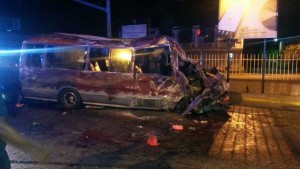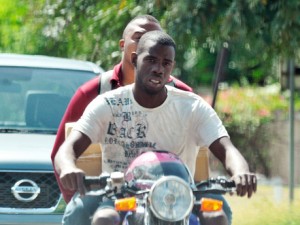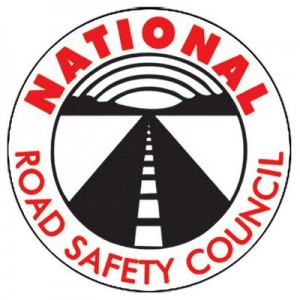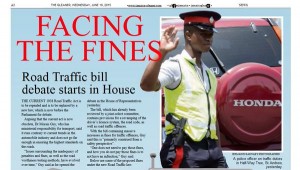
Highways and Byways and Bikes
June 16th, 2015
It was a regular, quiet Sunday morning in Half Way Tree, Kingston. Congregation members making their way to the 6:30 a.m. service at the St. Andrew Parish Church stopped short, in shock. Right in front of the historic church, the mangled wreckage of a shiny, psychedelic purple coaster bus and a small motor car. The bus had apparently crashed into the church’s brick wall, and overturned. Ten people had been taken to hospital, where the bus driver and another man died. There was conjecture that one of the vehicles had “run the red light” at around 4:00 a.m. – the time of day when drivers are tempted to do this kind of thing.

The coaster bus involved in the fatal crash outside St. Andrew Parish Church on Sunday morning – ironically, Vice President of the National Road Safety Council is a member of the congregation. (Photo: Gleaner)
Back in March, four employees of the Gran Bahia Principe Hotel in St. Ann were killed instantly when their car collided with a tractor trailer traveling in the opposite direction on the straight stretch of the Braco main road, where drivers often put their foot down and drive too fast. On this road, and many other “accident hot spots” around the island, not even police speed traps can slow them down. The instinct for speed seems unstoppable.
Then there are the motorbikes. As of last week, 46 motor cycle riders have died in Jamaica so far this year, as well as three pillion passengers. Very few of the victims were wearing a helmet, and most bikes were not insured or registered. Messenger bikes in town often take risks, swerving and dipping through traffic jams, but are more likely to wear some kind of protective gear. “Bike taxis” that are especially common in western Jamaica these days. Many are unlicensed, most do not wear helmets and nor do their pillion passengers. And there are what you might call the “show-off” riders – young people who want to impress, cut a style, drive like a stunt rider. Of course, for most of these riders it is completely uncool to wear crash helmets. A girl pillion rider wearing skimpy clothing (and no helmet) is also an asset. Naturally, they speed up whenever they get the chance. If they crash… Well, if you look at Google Images (and if you have a strong enough stomach) you will see what happens. There is nothing cool and stylish about being torn limb from limb or having your head crushed to a pulp.
I remember a dancehall deejay named Norman Washington Jackson. His stage name was Tiger. He was enormously popular, with a crazy growling voice – a unique style, with lots of character and humor. He became quite a star in the late 1980s, but in 1994 Tiger’s career came to an abrupt end. He had been making good money for some time, and motorbikes were a passion of his – like a new toy. One of his favorite occupations was to “burn up the tires” from the top to the bottom of Hope Road – a main road, and a busy one. He was a common sight on his latest motorbike, from Papine to Half Way Tree, up to all kinds of fun and games. Then just around the Christmas/New Year holiday, a car was pulling out of the Devon House complex when Tiger, flying along on his bike as usual, went straight into it. He suffered severe head injuries. Crowds at the University Hospital of the West Indies swore he was dead. But he survived, although a shadow of his former, ebullient self. The accident has affected his speech and memory. Those who survive road accidents suffer, too; and of course, those who mourn the sudden, devastating loss of family and friends. Their lives are never the same.
June is National Road Safety Month. The National Road Safety Council is pulling out all the stops, with a strong social media presence (#SaveKidsLives #RoadSafetyIsMyResonsibility #BeStreetSmart #Jamaica #RoadSafetyMonth) and a new, catchy Road Safety Anthem by Tessanne Chin and Agent Sasco, which you can find on the NRSC’s Facebook page and The focus is on children – and it has to be. The essence of this is education; we have to teach children to wear safety belts, for example, and to avoid distractions. They must be taught to recognize poor driving habits and good ones. Positive role modeling by parents of 5-12 year olds can have a major influence on their child’s future driving behavior. We must lead by example.
Right now, stricter regulations are being worked on and the Road Traffic Act (almost eighty years old) debated in Parliament, with much tougher sanctions for traffic violations anticipated. I am glad to hear that legislation to ban driving while using a cell phone is in the making, and it cannot come too soon for me. In fact, I hope it will be rushed through. When I see careless, one-handed driving in Kingston – a corner badly taken – I often notice the driver has a phone on his/her ear. Importantly, the
So why is there this “need for speed”? Is it just the adrenalin rush? Is it really worth it? I have no answers, but am convinced that speeding is a major factor. When you are driving too fast, you are not giving yourself any time to react if something unexpected happens.
The World Bank has some interesting (if depressing) statistics on road traffic accidents. Road traffic injuries are the eighth leading cause of death globally, and the leading cause of death among young adults between the ages of 15 and 24. In 2013, 1.3 million people were killed and another 50 million were injured in road crashes across the world. Significantly, 90% of these deaths occurred in low and middle-income countries. Of course, traffic accidents also have an impact on the Gross Domestic Product (GDP) of countries.
This madness on the road costs money, as well as lives.
Tags: motorbike, National Road Safety Council, Parliament, road accidents, road safety, Road Traffic Act, Tiger, World Bank
The Gleaner reserves the right not to publish comments that may be deemed libelous, derogatory or indecent.
To respond to The Gleaner please use the feedback form.
2 Responses to “Highways and Byways and Bikes”
- We Are the Zoomers
- Living Online with Humans and Birds: NAOC 2020
- Human Trafficking and the Problem of Public Education
- Down Memory Lane
- Are We Ready to Recover from COVID-19?
- Road Safety Matters: Is Your Vehicle Safe?
- Sexual Harassment, Me Too, and the Minister’s Disturbing Giggle
- The Vulnerable Senior Citizens, Private Care Homes and COVID-19
- A Muddle Over Masks
- Here is Something Life-Saving You Can Do: Give Blood!






To many riders without helmets, to many breaking the red lights and stop signs, too many overtaking recklessly
Yes, I know. Those are the major concerns. How on earth do we get people to see sense? I am not sure how one can go about it. Suggestions are welcome!